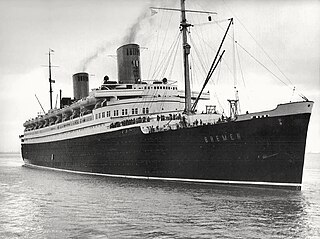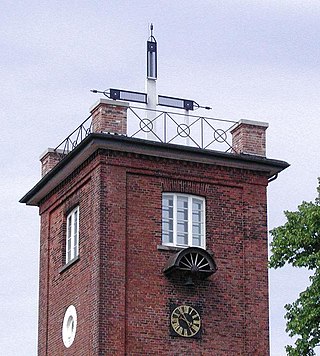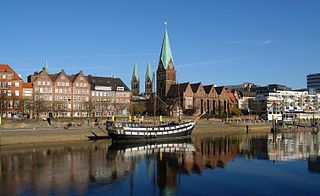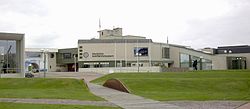
The Weser is a river of Lower Saxony in north-west Germany. It begins at Hannoversch Münden through the confluence of the Werra and Fulda. It passes through the Hanseatic city of Bremen. Its mouth is 50 km (31 mi) further north against the ports of Bremerhaven and Nordenham. The latter is on the Butjadingen Peninsula. It then merges into the North Sea via two highly saline, estuarine mouths.

Aktien-Gesellschaft "Weser" was one of the major German shipbuilding companies, located at the Weser River in Bremen. Founded in 1872 it was finally closed in 1983. All together, A.G. „Weser" built about 1,400 ships of different types, including many warships. A.G. „Weser" was the leading company in the Deutsche Schiff- und Maschinenbau AG, a cooperation of eight German shipbuilding companies between 1926 and 1945.

Bremen, officially the Free Hanseatic City of Bremen, is the smallest and least populous of Germany's 16 states. It is informally called Land Bremen, although the term is sometimes used in official contexts. The state consists of the city of Bremen and its seaport exclave, Bremerhaven, surrounded by the larger state of Lower Saxony in northern Germany.

German submarine Wilhelm Bauer is a Type XXI U-boat of Nazi Germany's navy (Kriegsmarine), completed shortly before the end of World War II. It was scuttled at the end of the war, having never gone on patrol. In 1957, it was raised from the seabed off Flensburg Firth, refurbished, and recommissioned for use by the West-German Bundesmarine in 1960. Finally retired fully in 1983, it is the only floating example of a Type XXI U-boat. It has been modified to appear in wartime configuration and exhibited at the German Maritime Museum in Bremerhaven, Germany.

SS Bremen was a German-built ocean liner constructed for the Norddeutscher Lloyd line (NDL) to work the transatlantic sea route. Launched in 1928, Bremen was notable for her high-speed engines and low, streamlined profile. At the time of her construction, she and her sister ship Europa were the two most advanced high-speed steam turbine ocean liners of their day. The German pair sparked an international competition in the building of large, fast, luxurious ocean liners that were national symbols and points of prestige during the pre-war years of the 1930s. She held the Blue Riband, and was the fourth ship of NDL to carry the name Bremen.
Norddeutscher Lloyd was a German shipping company. It was founded by Hermann Henrich Meier and Eduard Crüsemann in Bremen on 20 February 1857. It developed into one of the most important German shipping companies of the late 19th and early 20th centuries, and was instrumental in the economic development of Bremen and Bremerhaven. On 1 September 1970, the company merged with Hamburg America Line (HAPAG) to form Hapag-Lloyd AG.

Alexander von Humboldt is a German sailing ship originally built in 1906 by the German shipyard AG Weser at Bremen as the lightship Reserve Sonderburg. She was operated throughout the North and Baltic Seas until being retired in 1986. Subsequently, she was converted into a three masted barque by the German shipyard Motorwerke Bremerhaven and was re-launched in 1988 as Alexander von Humboldt. In 2011 the ship was taken off sail-training and sent to the Caribbean for the charter business, then she was converted to a botel.

Vegesack is a northern district of Bremen, the capital of the German state Free Hanseatic City of Bremen.

Bremer Vulkan AG was a prominent German shipbuilding company located at the Weser river in Bremen-Vegesack. It was founded in 1893 and closed in 1997 because of financial problems and mismanagement.

Brake is the district seat of Wesermarsch district in northern Germany.

Bremen, officially the City Municipality of Bremen, is the capital of the German state of the Free Hanseatic City of Bremen, a two-city-state consisting of the cities of Bremen and Bremerhaven. With about 577,000 inhabitants, the Hanseatic city is the 11th-largest city of Germany and the second-largest city in Northern Germany after Hamburg.

Bremerhaven is a city on the east bank of the Weser estuary in northern Germany. It forms an exclave of the city-state of Bremen. The River Geeste flows through the city before emptying into the Weser.

The Bremen cog is a well-preserved wreck of a cog dated to 1380, found in 1962 in Bremen. Today, it is displayed at the German Maritime Museum in Bremerhaven as one of the main features. Three nearly identical replicas of this cog have been built: Ubena von Bremen, Hansekogge, and Roland von Bremen.

The Museum of Maritime Science is a marine science museum located in Higashiyashio, Shinagawa, Tokyo on Odaiba island, Japan.

The Schlachte is a promenade along the east bank of the River Weser in the old town of Bremen in the north of Germany. Once one of the city's harbours, it is now popular for its restaurants, beer gardens and river boats.

The Ports of Bremen, Bremen Ports or Bremish Ports, in German "Bremische Häfen" consist of the commercial ports in Bremen and Bremerhaven. They are managed by bremenports GmbH & Co. KG, a company of private status in public property.

Langer Heinrich, or in English Long Henry, is a floating crane commissioned in 1915 for the Wilhelmshaven Imperial Shipyard in Wilhelmshaven, Germany and has been located in Genoa, Italy since 1997. At the time of completion she was the largest floating crane in the world, passing up the Ajax crane barge completed in 1914.

K Line European Sea Highway Services GmbH (KESS) is a roll-on/roll-off shipping line based in Bremen, Germany and is a subsidiary of the Japanese shipping line K Line.

Submarine signals had a specific, even proprietary, meaning in the early 20th century. It applied to a navigation aid system developed, patented and produced by the Submarine Signal Company of Boston. The company produced submarine acoustic signals, first bells and receivers then transducers, as aids to navigation. The signals were fixed, associated with lights and other fixed aids, or installed aboard ships enabling warning of fixed hazards or signaling between ships. ATLAS-Werke, at the time Norddeutsche Maschinen und Armaturenfabrik, of Germany also manufactured the equipment under license largely for the European market.

Pundt & Kohn OHG was a German timber import and wood processing company. It was founded in 1862 by F. J. S. Kohn in Geestemünde. Until it was destroyed by Allied bombing in 1944, it was one of the oldest and most important companies in its branch on the lower Weser. The company was dissolved in the third generation in 1967 after the death of its last owner, Hans Kohnert.






















